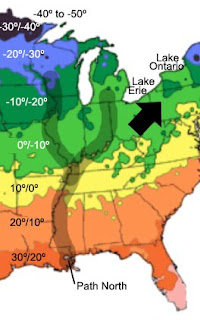 This chart shows the Annual Low Temperatures of the Eastern U.S. Note that the area of the suggested Land of Promise (black arrow) around Lake Erie and Lake Ontario show an annual low of 0º to -20º. The gray area (Path North) is the movement of grain crops which began in the south and slowly moved their way north around 100 A.D., reaching the Land of Promise area around 400 to 500 A.D.
This chart shows the Annual Low Temperatures of the Eastern U.S. Note that the area of the suggested Land of Promise (black arrow) around Lake Erie and Lake Ontario show an annual low of 0º to -20º. The gray area (Path North) is the movement of grain crops which began in the south and slowly moved their way north around 100 A.D., reaching the Land of Promise area around 400 to 500 A.D.According to archaeologists, maize (corn) made its way up from the southern states of the American South, moving up the Mississippi to the Great Lakes area, arriving early in the first century A.D. Corn reached Ontario by 500 A.D., “however, it took some time until people in the Great Lakes became full-time farmers.”
• Compare that to: “And we began to till the ground, yea, even with all manner of seeds, with seeds of corn, and of wheat, and of barley, and with neas, and with sheum, and with seeds of all manner of fruits” (Mosiah 9:9). This occurred about 200 B.C., and obviously, those seeds were brought with Zeniff’s group from the area of Zarahemla, which would have been growing there earlier than 200 B.C. In addition, we know that the Lehi Colony planted seeds for their sustenance as early as 600 B.C. (1 Nephi 18:24), and before them the Jaredites planted their crops (Ether 6:13) as early as 2200 B.C.
Archaeologists also claim that the seeds, which arrived in the Great Lakes region in the first century A.D., had to have undergone a climate change. That is, the seeds “had to adopt to the cold climate of the Great Lakes.” And this over time as the seeds made their way up the Mississippi from the southern states area, including later beans and squash from Mexico.
• Compare that to: “Lehi dwelt at Jerusalem in all his days” (1 Nephi 1:4), and that upon departing into the wilderness (1 Npehi 2:4), he took with him provisions which included “all manner of seeds of every kind, both of grain of every kind, and also of the seeds of fruit of every kind” (1 Nephi 8:1), and upon boarding the ship Nephi built, they “did go down into the ship, with all our loading and our seeds, and whatsoever thing we had brought with us” (1 Nephi 18:6). An when they arrived in the Land of Promise, they “did begin to till the earth, and we began to plant seeds; yea, we did put all our seeds into the earth, which we had brought from the land of Jerusalem. And it came to pass that they did grow exceedingly; wherefore, we were blessed in abundance” (1 Nephi 18:24). And when Nephi separated from his brothers, and traveled many days into the wilderness, “the Lord was with us; and we did prosper exceedingly; for we did sow seed, and we did reap again in abundance. And we began to raise flocks, and herds, and animals of every kind” 2 Nephi 5:11). It should be noted that seeds “brought from the land of Jerusalem” had grown in a Mediterranean climate. In 600 B.C., seeds grew in the climate and soils they were used to, and the Great Lakes is far too cold for seeds from a Mediterranean climate to grow. In fact, there are only four Mediterranean climates in the world outside the Mediterranean. They are southern tip of Africa, southern tips of Australia, southern California, and 30º south latitude in Chile. Nephi’s seeds would not have grown initially in any climate but these four.
Archaeologists also claim that from the period 400 B.C. to 500 A.D., the people of the Great Lakes region were “hunters and gatherers.”
• Compare this to the Nephites who built major cities (City of Nephi, the City of Zarahemla) and 46 other cities in the Land of Promise during this time. Many are mentioned in 3 Nephi 9, when they were destroyed. The point is, hunters and gatherers do not build cities. Nor highways and roads, which were constructed around 30 A.D. (3 Nephi 6:8)
Archaeologists also claim that the people of the Great Lakes who built the Norton Mound Group in Michigan did so somewhere between 1 and 200 AD. And also that “some sites near the mouths of rivers, are remaining where they are for a longer period of time—in other words, people are becoming more sedentary.”
• Compare this to the fact that in the first and second century A.D., after Christ’s appearance to the surviving Nephites (3 Nephi 9:15), around 50 A.D., the Nephites were again building cities (4 Nephi 1:7), including “that great city Zarahemla” (4 Nephi 1:8). During this 200 years following Christ’s appearance, the Nephites were an enlightened people, building cities, and multiplied exceedingly fast (4 Nephi 1:10) spreading across the land. Archaeologists have not found any comparable happening in the Great Lakes are to equate to this spiritual and technological growth in the first two centuries A.D.
(See the next post, “The Great Lakes Myth and the Scriptural Record – Part III,” regarding the height of the Great Lakes peoples not existing until several centuries after the annihilation of the Nephites)




No comments:
Post a Comment